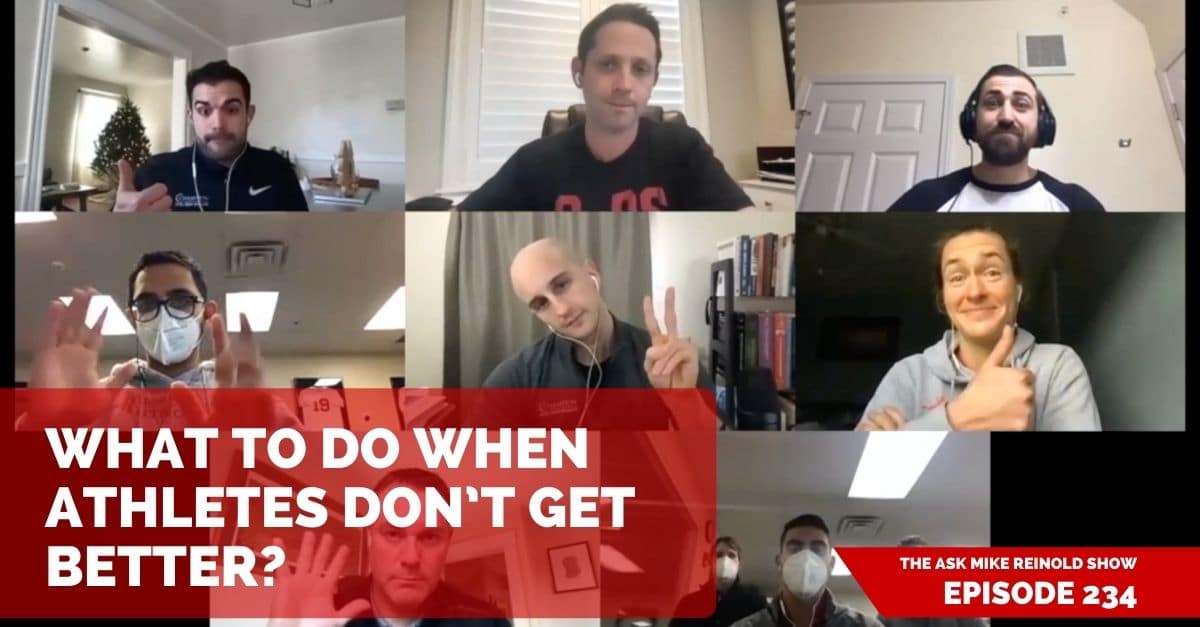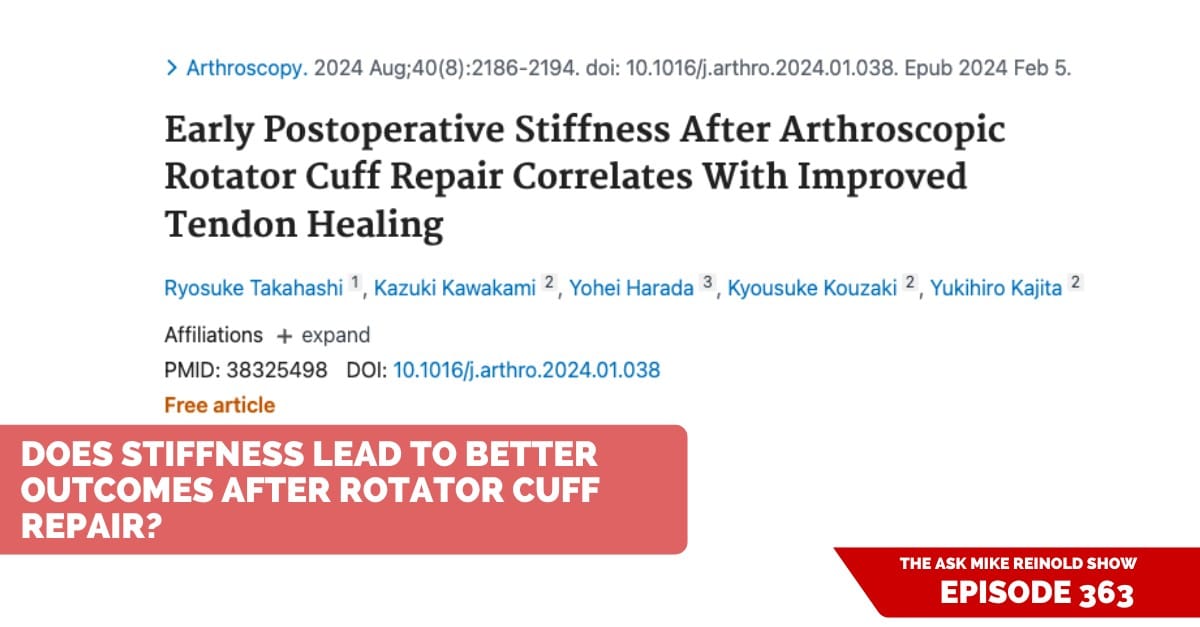On this episode of the #AskMikeReinold show we talk about how we handle a lack of progress, or even regression, in our athletes when rehabbing from an injury. To view more episodes, subscribe, and ask your questions, go to mikereinold.com/askmikereinold.
#AskMikeReinold Episode 234: What to Do When Athletes Don’t Get Better
Listen and Subscribe to Podcast
You can use the player below to listen to the podcast or subscribe. If you are enjoying the podcast, PLEASE click here to leave us a review in iTunes, it will really mean a lot to us. THANKS!
Transcript
Student:
Hayes from Tampa wants to know do you ever have athletes who don’t get better with conservative care?
Mike Reinold:
Fantastic. All right. Thanks Johnny, appreciate it.
Lenny Macrina:
So what do you do?
Mike Reinold:
That’s awesome. So Hayes from Tampa says, do you ever have athletes who don’t get better with conservative care? If so, what do you do? I like this question. This is pretty good, right? Because this is the humble pie question. I’ll start it off and just say no, all my people always get better. I don’t know. I mean, who wants to take this one on? I mean, to answer your question, Hayes, just briefly, and then maybe we can all kind of elaborate on this a little bit of maybe why we see this, why it happens, and what we can do about it. But yeah, as you get more and more into your career, you’re going to realize that, I mean, we can’t fix everything. We do a really good job putting people in position to succeed, but sometimes they’re either too far along the lines or sometimes they just don’t help themselves, and that’s kind of part of the problem sometimes too. So I’ll say yeah, of course we definitely deal with that. Let’s see. Did anybody have any experiences or anything they want to share about maybe why this happens? Who wants to jump in first?
Dan Pope:
I guess I’ll say a little bit.
Mike Reinold:
One at a time. All right, you’re up, Pope.
Dan Pope:
Okay. I guess kind of as a new grad, you really want to help people as much as possible. So when someone’s not making the progress you want, it’s really upsetting. I think what’s important to keep in mind first and foremost, is that a lot of these conditions, A, they take longer to get better than you may think. So many months, oftentimes traditional physical therapy, maybe that’s four to six weeks. How many people are going to get better during that time? And the second piece is what does better mean? Oftentimes better doesn’t mean you have a complete resolution of symptoms, but you make some sort of improvement. So I think that’s probably the first thing to keep in mind before you start saying, “Okay, I failed, I did something wrong. This person needs to get surgery,” or something along those lines.
Mike Reinold:
I like it. That makes sense. And good point right there. I mean better doesn’t necessarily mean a hundred percent sometimes, especially if you’re an athlete getting ready for a season or in season, there’s probably some challenging stress that they’re dealing with on their body. Sometimes better is just getting them to be able to perform again. So who else who wants to jump in? Lisa?
Lenny Macrina:
Go ahead, Lisa, do it.
Lisa Russell:
Sure. Just, can you hear me?
Mike Reinold:
Yep.
Lisa Russell:
Okay. Just a simple example, even just last week, I had a high school athlete come in who was looking for help with some knee pain. And he had history of [inaudible 00:05:07] and his tibial tuberosity was pretty thick. He had some really big bony overgrowth there. And he was looking for help with this knee pain of like, “Oh, sometimes I bump it on a corner and it really hurts.” And I was like, “Well, I can’t change that. That’s bone. I can’t change that.” So just, I feel like I’ve learned to try and let somebody know essentially, I can help you with this bubble of things. But if it’s a bony thing or something that would require a surgical change if you really wanted it, I’m not going to be able to do anything there. And that was like a super simple, I mean, PT is just not going to change that kind of pain. So, yeah, that was just recently. So just a simple example.
Mike Reinold:
Yeah, good point. I mean, we can’t change a lot of people’s anatomy sometimes. So I think that’s a good second thought process here is sometimes anatomically, if you have some predisposed anatomical position, so maybe an alignment issue with your hips or something, and you choose a sport that happens to just butt bone into bone, for example, I mean, that’s something that we’re going to have a very difficult time doing. Who else? Who else has anything on here? What do you got, Len?
Lenny Macrina:
Yeah, I mean, I treat a lot and probably Scaduto too can probably talk as well, but we treat a lot of baseball obviously. So we do a lot of non-op or trying to be non-op Tommy John injuries or labral tears in their shoulder. And once I had somebody present to me in the docs, no, go to PT, there’s a way that we can avoid surgery. We got to set up a game plan ahead of time. So I think that’s key for this person is, what are you trying to achieve during this rehab? And how much time do you think we have? And then you’ve got to plan out if we don’t hit our goals, meaning pain-free whatever, throwing or whatever it is, then you need to have a date where you need to potentially have that conversation where maybe we’re sending you back to the doctor. So for us, I’m planning ahead. If I can get you to this point and throw and you’re pain-free, then you’re good. But if you’re still having pain at this time and we have a surgery, I can save your next season or your next, whatever you’re trying to get to, because I know it’s going to take nine to 12 months of rehab.
Lenny Macrina:
So you’re not going to see that with an ACL too much. A lot of people talk about copers and non copers, but for us, the UCLs of the elbow and the labrums of the shoulder, we are coming up with a strategy, what we found in our objective measurements, you got some obvious weakness, you had some pain because you were overdoing it, and maybe it was a volume issue, or you’re doing a new program, some weighted balls or something. And then we break it down and come up with a game plan for them and create smaller goals so we can hit that. If not, we have almost a drop dead date so we can get you ready for the next season.
Mike Reinold:
Yeah. And oftentimes it doesn’t work, right, Len? Because maybe structurally, maybe you damaged your ligaments so much that it’s just beyond the point where it’s going to heal so, awesome. What’s up, Dave? What do you think?
Dave Tilley:
Yeah, I think kind of this is unfortunately the elephant in the room for my sport, for gymnastics, but Lisa was talking about things you can control versus things you can’t control, where you can’t control other people. I have a lot of dead ends where in my heart I realize that the gym they’re a part of, the coach they’re working under, the parent’s influence, and that kind of stuff is like, they need to change maybe their thoughts about how much they train and how many reps they do and their strength conditioning. And it’s such a hard conversation to have, but there’s been times when I’m just like, “Well, until we really have a hard conversation about why you’re training six days a week and five hours a day, and you don’t want to do anything in the off season, but do gymnastics, this is a really hard uphill battle.”
Dave Tilley:
So as a young, new grad, like Dan said, I wanted to kind of save everybody and see if I could change the world and you quickly realize that some people just aren’t open to hearing what you have to say. And so, I mean, we have great systems, I think, at Champion and still people just refuse to have an open ear. So you’ve got to realize, okay, I’ve done all that I can and I’ll help you out. But I think there’s a bigger fish to fry here.
Mike Reinold:
I like that. And I think the only other thing I’d add, just briefly, just to kind of, I guess, wrap it up here is that oftentimes when we’re dealing with athletes that are having an issue, we’re not just completely shutting them down and rehabbing them at this really low baseline with just infinite amount of time. Oftentimes we’re either trying to flirt with that line of injury, where we’re trying to get them back as fast and as safely as we can, but we’re flirting with as fast as we can. That’s kind of sometimes the most important thing that we do. So sometimes we kind of dip into that too much. So kind of like what Dan said at the beginning of this a little bit here is just, sometimes we have to define what’s better, I guess is the question, but something to kind of keep in mind.
Mike Reinold:
So great question. I think that it was super helpful because I think a lot of people probably deal with that. And I think a lot of people early in their careers are very self-conscious of that. They feel bad that we can’t help everybody, but just remember, even the progress that you make with somebody, even if they don’t fully resolve their issues is probably some pretty substantial progress for them. If they end up having surgery or something, that’s going to make their postoperative success rate probably even higher. So lots of benefits still from doing that sort of stuff. So awesome question, Hayes, appreciate it. Thank you so much for submitting one. If you have a question like that, please head to MikeReinold.com, Click on that podcast link and keep asking away. Please again, iTunes, Spotify, head there, rate, review, and we will see you on the next episode. Thanks again.





